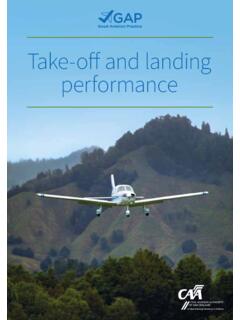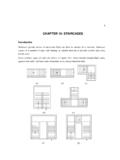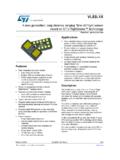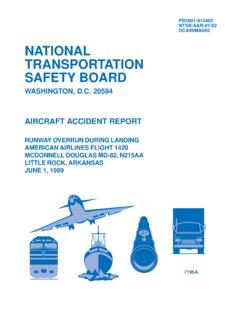Transcription of ORDER 6750.16E SITING CRITERIA FOR INSTRUMENT …
1 ORDER SITING CRITERIA . FOR. INSTRUMENT landing SYSTEMS. April 10, 2014. DEPARTMENT OF TRANSPORTATION. federal aviation administration . Distribution: A-WXYZ-1; A-FFS-0 (SUPV); A-FIA-0 (SUPV) Initiated By: AJM-3221. A-FAS-1 (SUPV); A-FAT-2 (SUPV); A-FAF-0 (LTD). RECORD OF CHANGES DIRECTIVE NO CHANGE. CHANGE SUPPLEMENT OPTIONAL TO SUPPLEMENT OPTIONAL. TO BASIC. BASIC. FAA FORM 1320-5 (6-80) USE PREVIOUS EDITION. ORDER . National Policy Effective Date: 04/10/14. SUBJ: SITING CRITERIA for INSTRUMENT landing Systems The material in this ORDER is a result of a total review of ORDER The purpose of the revision is to delete obsolete material that addressed antenna systems and other units that are no longer used, certain practices and requirements that are no longer required, and items of a similar nature.
2 Distribution: A-WXYZ-1; A-FFS-0 (SUPV); A-FIA-0 (SUPV); Initiated By: AJM-3221. A-FAS-1 (SUPV); A-FAT-2 (SUPV); A-FAF-0 (LTD). 4/10/2014 Table of Contents Paragraph Page Chapter 1. General Information 1. Purpose of This ORDER .. 1-1. 2. Audience .. 1-1. 3. Where Can I Find This ORDER ?.. 1-1. 4. Cancellation.. 1-1. 5. Explanation of Policy Changes .. 1-1. 6. 1-2. 7. Directive Verbs.. 1-2. 8. Procedures.. 1-2. 9. Introduction.. 1-3. 10. ILS Establishment CRITERIA .. 1-3. 11. ILS Components as 1-4. 12. National Airspace System Change Proposal (NCP).. 1-4. 13. General Description of the ILS.. 1-5. 14. SITING Effects on ILS Operations .. 1-5. 15. Multiple ILS 1-6. 16. ILS Critical Areas.
3 1-8. 17. ILS Shelter Standards .. 1-14. 18. Reserved.. 1-14. Chapter 2. The ILS Localizer 1. General Description.. 2-1. 2. Localizer Location and Types.. 2-4. 3. Localizer Equipment 2-4. 4. Description of the Antenna Systems .. 2-5. 5. SITING Requirements .. 2-6. 6. Ground Check Points .. 2-11. 7. Site Effects on Localizer Performance .. 2-12. 8. Reserved .. 2-18. Chapter 3. The ILS Glide Slope 1. General Description.. 3-1. 2. Glide Slope Antenna Array Selection .. 3-2. 3. Terrain Considerations for Image-Type Glide Slopes .. 3-2. 4. Site Preparation .. 3-8. 5. Reserved.. 3-10. 6. End-Fire Glide Slope CRITERIA .. 3-12. 7. Locating the Glide Slope Facility .. 3-13. 8. Physical Requirements.
4 3-27. 9. Required Obstruction Clearance (ROC).. 3-27. 10. Summary .. 3-27. i 4/10/2014 Paragraph Page Chapter 4. Marker Beacons and Ancillary Aids 1. General Information .. 4-1. 2. distance Measuring Equipment (DME).. 4-1. 3. Marker Beacons.. 4-1. 4. Non-Directional Beacons and Low Power NDBS .. 4-5. 5. Reserved .. 4-6. Chapter 5. Monitor and Control Requirements 1. General Requirements .. 5-1. 2. Control Requirements .. 5-2. Chapter 6. ILS Power Requirements 1. Facility Requirements .. 6-1. 3. Installation Requirements .. 6-1. 4. Standby Power .. 6-1. 5. Continuous Power Airport .. 6-1. 6. Reserved.. 6-1. Chapter 7. Project Engineering and Facility Establishment 1. General Procedure.
5 7-1. 2. Preliminary Survey .. 7-1. 3. Preliminary Report.. 7-1. 4. Final Engineering Activities .. 7-2. 5. Site Testing .. 7-2. Appendix 1. 1. Appendix 2. Localizer Site Effects .. 1. Appendix 3. Glide Slope Site Effects .. 1. Appendix 4. RDH/ARDH Considerations .. 1. ii 4/10/2014 List of Figures Figure Page 1-1 Multiple ILS Configurations .. 1-8. 1-2 Category I, II, & III Localizer Critical Area .. 1-11. 1-3 Image Glide Slope Critical Area .. 1-12. 1-4 End Fire Glide Slope Critical Area .. 1-13. 2-1 ILS Course Displacement Reference Points .. 2-2. 2-2 Typical Localizer Degrading Sources .. 2-3. 2-4 Typical Localizer Plot Layout and Site Grading Requirements .. 2-11. 2-5 Localizer Ground Check Points.
6 2-12. 2-6 LPD vs. V-Ring .. 2-15. 2-7 SBO Pattern Comparison .. 2-16. 2-8 8-Element Array (45-Foot Aperture) .. 2-17. 2-9 14-Element Array (86-Foot Aperture) .. 2-18. 3-1 Image Antenna Concept .. 3-3. 3-2 First Fresnel Zones For ILS Glide Slope .. 3-4. 3-3 Location Of Glide Slope Geometric Ground Reflection Points .. 3-5. 3-4 Location Of Glide Slope Fresnel Zone Centers .. 3-6. 3-5 First Fresnel Zone Length as Function of Glide Angle and Aircraft distance from Glide 3-6. 3-6 First Fresnel Zone Width as Function of Glide Angle and Aircraft distance from Glide 3-7. 3-7 Grading CRITERIA for Image-Type ILS Glide Slopes .. 3-11. 3-8 Expected Applicability of Glide Slope Systems to Different SITING Conditions.
7 3-12. 3-9 Identification of Glide Slope SITING Parameters .. 3-15. 3-10a Typical End-Fire Glide Slope Equipment Layout Dual-Clearance Configuration .. 3-18. 3-10b Typical End-Fire Glide Slope Equipment Layout Single-Clearance Configuration .. 3-19. 3-11 Glide Slope Site with Ideal Terrain .. 3-20. 3-12 Longitudinal Terrain Slope Down from Glide Slope to Threshold .. 3-21. 3-13 Longitudinal Terrain Slope Up from Glide Slope to Threshold .. 3-21. 3-14 Pedestal Case, Height A .. 3-22. 3-15 Glide Slope Site with Positive Terrain Slope .. 3-24. iii 4/10/2014 Figure Page 3-16 Glide Slope Site with Negative Terrain Slope .. 3-25. 3-17 Site with Irregular Slope .. 3-26. 4-1 SITING CRITERIA for Collocated Marker Beacon and Low Power NDB.
8 4-4. 4-2. Typical NDB Layout and Plot Size Requirements .. 4-5. Appendix 2. A2-1. Scalloping Effect Orbital A2-2. Scalloping Effect Radial Flight ..3. A2-3. Scalloping Effect Angular Flight ..4. A2-4. Analysis of Scalloping Example A2-5. Analysis of Scalloping Example A2-6. Analysis of Scalloping Example A2-7. Signal Cancellation A2-8. Effect of a Cancellation Wire on a Reflected Signal ..9. A2-9. AC Power Line Signal Reflection Cancellation ..10. Appendix 3. A3-1. Fresnel Zone for ILS Glide Slope ..2. A3-2. Effect of Rough Terrain on Glide Path ..6. A3-3. Terrain Roughness Appendix 4. A4-1 RDH (a) and ARDH (b) versus Longitudinal distance from the Antenna Mast to Threshold, for Antenna Mast Offset Distances from Centerline of 250, 450, and 650 Feet, for a Path Angle of Degrees.
9 3. A4-2. Illustration of the Effect of a Uniform, Longitudinal, Up-Sloping Terrain Gradient on the RDH ..4. A4-3a. Illustration of a CEGS with Stepped Terrain, Depicting the Modeled Differences between RDH/ARDH and A4-3b. Illustration of of a CEGS with Multiple Slope Terrain, Depicting the Modeled Differences between RDH/ARDH and TCH ..5. iv 4/10/2014 List of Tables Page 2-1. Localizer Antenna Arrays .. 2-6. 2-2. Minimum Normal Course Width for Single-Frequency Localizer Arrays for which Greater Than 60% Abnormal Case DDM will not occur .. 2-14. 4-1 Typical ILS Marker Characteristics .. 4-2. 4-2. Marker Beacon SITING Tolerances .. 4-2. v 4/10/2014 Chapter 1. General Information 1. Purpose of This ORDER .
10 This ORDER provides guidance to engineering personnel engaged in the SITING of federal aviation administration (FAA) INSTRUMENT landing systems (ILS). Sufficient information, supplemented by relevant drawings, will enable the engineer to select the optimum site, within defined limits, for each of the subsystems that comprise a Category I, II, or III ILS. Because of the wide variation in ILS SITING conditions, it is not possible to provide specific instructions on how to overcome or offset the effects of each adverse condition. This ORDER provides guidelines that are used in conjunction with a thorough understanding of ILS. facility operations to arrive at the optimum site and operating parameters.














